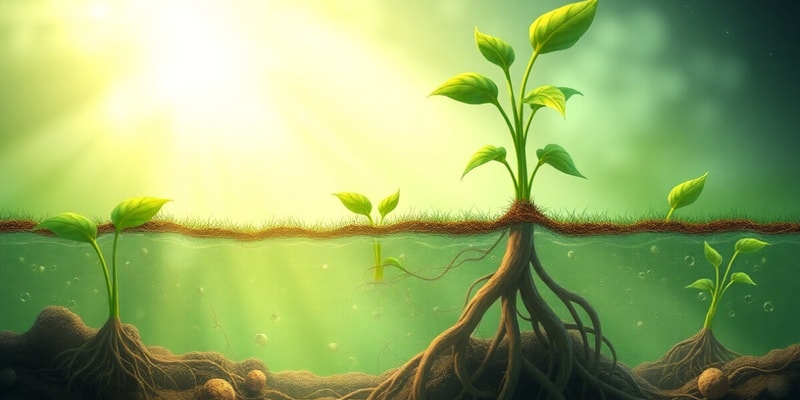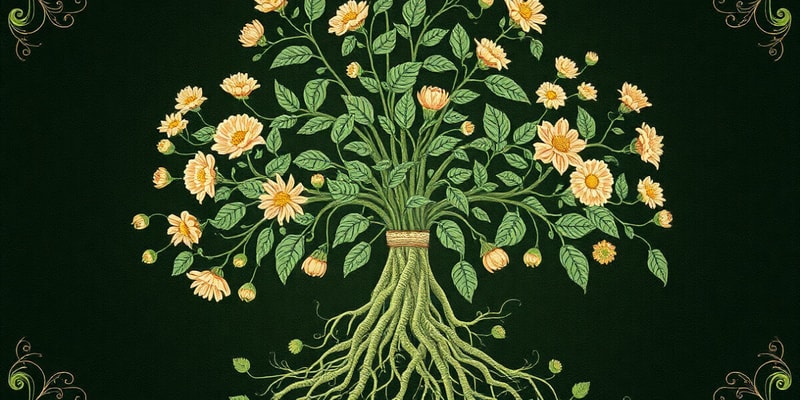Podcast Beta
Questions and Answers
What role do lateral meristems play in plant growth?
Which feature is NOT characteristic of apical meristems?
What is the primary function of the ground tissue in leaves?
What results in the formation of tree rings?
Signup and view all the answers
What is the primary purpose of the epidermis in plant tissue?
Signup and view all the answers
What is primarily conducted by the shoots (stems) of a plant?
Signup and view all the answers
Which type of growth is primarily associated with the apical bud?
Signup and view all the answers
What role do mycorrhizae play in a plant's root system?
Signup and view all the answers
Which structure is primarily responsible for nutrient and water exchange in plants?
Signup and view all the answers
What characteristic is NOT a function of stems?
Signup and view all the answers
What is a unique feature of specialized subterranean stems, such as rhizomes?
Signup and view all the answers
In plant anatomy, what distinguishes internodes from nodes?
Signup and view all the answers
What is not a role associated with chlorophyll in plants?
Signup and view all the answers
What is the primary benefit of a plant's leaves undergoing photosynthesis?
Signup and view all the answers
Which of the following best describes the function of alternating nodes?
Signup and view all the answers
What is the primary function of taproots in plants?
Signup and view all the answers
Which type of root primarily contributes to water and nutrient absorption due to its large surface area?
Signup and view all the answers
How do root hairs enhance the absorption capabilities of plants?
Signup and view all the answers
Mycorrhizae play a significant role in plant root systems by:
Signup and view all the answers
During seed germination, the initial primary root can develop into which types of roots?
Signup and view all the answers
Which characteristic is NOT associated with fibrous roots?
Signup and view all the answers
What is the main benefit of having a larger surface area in the root system?
Signup and view all the answers
What is a primary characteristic of taproots compared to lateral roots?
Signup and view all the answers
What is the primary function of the shoots (leaves) in a Venus flytrap?
Signup and view all the answers
What process describes the equation CO2 + H2O -> C6H12O6 + O2?
Signup and view all the answers
Which structure is primarily involved in minimizing water loss in plants?
Signup and view all the answers
What does thermoregulation in plants primarily help to control?
Signup and view all the answers
What is a secondary role of the leaves in a Venus flytrap, aside from photosynthesis?
Signup and view all the answers
Which type of plant tissue serves as the 'skin' to defend against damage and invaders?
Signup and view all the answers
Which component of a leaf can be specialized for specific functions related to plant needs?
Signup and view all the answers
Which statement accurately describes plant tissues?
Signup and view all the answers
What is the main benefit of the high variation in leaf structures in plants?
Signup and view all the answers
Which of the following describes the functions of the petiole in leaves?
Signup and view all the answers
What is the primary role of xylem in plants?
Signup and view all the answers
Which type of tissue is primarily responsible for photosynthesis and storage in plants?
Signup and view all the answers
What is the function of guard cells in plants?
Signup and view all the answers
Sclerenchyma is characterized by which of the following attributes?
Signup and view all the answers
What role do trichomes play in plants?
Signup and view all the answers
Where is the cortex located in relation to vascular tissue?
Signup and view all the answers
What does collenchyma tissue provide to young plants?
Signup and view all the answers
Which of the following best describes periderm in plants?
Signup and view all the answers
What type of plant tissue is involved in the transport of sugars?
Signup and view all the answers
Which type of tissue is NOT considered vascular or dermal?
Signup and view all the answers
Study Notes
Roots
- Roots grow from the primary root during seed germination, and can be either taproots or lateral roots.
- Taproots grow vertically and provide stability, acting as an anchor for the plant.
- Lateral roots grow horizontally and are primarily responsible for water and nutrient absorption due to their increased surface area.
- Root hairs and mycorrhizae further enhance absorption by increasing surface area.
- Mycorrhizae are symbiotic fungi that live in the soil and provide increased surface area for nutrient absorption in exchange for food.
Shoots (Stems)
- Shoots are the above-ground structures of a plant that support leaves and facilitate functions like transport, photosynthesis, and reproduction.
- Stems consist of alternating nodes, where leaves attach, and internodes, the spaces between nodes.
- Growth occurs at the apical bud (tip) and axillary buds (at nodes).
- Stems can be specialized for asexual reproduction or food storage, such as rhizomes, which produce clones of the plant.
Shoots (Leaves)
- Leaves are the primary site of photosynthesis, converting carbon dioxide and water into glucose and oxygen.
- Leaves also play a role in thermoregulation and defense.
- Leaves are highly diverse and adapted to specific environmental conditions.
- Generally, leaves consist of a blade and a petiole.
Plant Tissues
- Plant tissues are groups of similar cells that perform a specific function.
- Plant tissues form continuous tissue systems that are classified into three types: dermal, vascular, and ground.
- Dermal tissue covers the plant's outer surface and provides protection from damage and pathogens.
- Vascular tissue transports water and nutrients throughout the plant.
- Ground tissue fills in spaces between the dermal and vascular tissues and performs various functions.
Dermal Tissue
- The epidermis is the outermost layer of dermal tissue that acts as the plant's "skin," protecting it from damage and invaders.
- The cuticle is a waxy coating that minimizes water loss from the plant.
- Guard cells control the opening and closing of stomata, pores that regulate gas exchange and water loss.
- Trichomes are specialized defense structures that can protect the plant from insects and UV radiation.
Vascular Tissue
- Xylem is responsible for transporting water and dissolved minerals from the roots to the shoots.
- Phloem transports sugars produced during photosynthesis throughout the plant.
Ground Tissue
- Ground tissue fills in spaces between the dermal and vascular tissues.
- Pith is located internal to the vascular tissue and can store food or water.
- Cortex is located external to the vascular tissue and can perform various functions, including storage and photosynthesis.
Plant Growth and Development
- Plant cells undergo differentiation to specialize for specific roles.
- Plant growth is indeterminate, meaning plants can grow throughout their lifespan.
- Meristems are undifferentiated tissues responsible for continuous growth.
- Apical meristems are located at the tips of roots and shoots and enable primary growth (elongation).
- Lateral meristems are found along the length of roots and shoots and facilitate secondary growth (widening).
Primary Growth (Elongation)
- Primary growth increases the length of roots and shoots.
- Root growth occurs in specific zones: the root cap protects the root tip, the zone of cell division produces new cells, the zone of elongation stretches cells, and the zone of differentiation specializes cells into different tissue types.
- Shoot growth also follows similar zones of cell division, elongation, and differentiation.
- Apical dominance occurs when the apical bud inhibits the growth of nearby axillary buds, resulting in a taller, less branched plant.
Secondary Growth (Width)
- Secondary growth increases the width of stems and roots, particularly in woody plants.
- Vascular cambium produces secondary xylem (wood) and secondary phloem, contributing to increased width.
- Cork cambium produces tough, waxy cells that protect the plant from water loss, pathogens, and insects.
- Tree rings are formed from the alternating patterns of cell growth during different seasons.
- Early wood, formed during the spring, has large, thin-walled cells to efficiently transport water.
- Late wood, formed later in the season, has thicker cell walls to provide more support and reduced water transport.
Woody Tissue
- Secondary xylem in stems is organized into heartwood, which is older and non-active, and sapwood, which is newer and active in water transport.
- Bark encompasses the secondary phloem and cork and provides protection for the plant.
- Maple syrup is made from the concentrated sap collected from the secondary phloem layer.
Plant Development
- Plant development involves a series of changes leading to the formation of cells, tissues, organs, and the entire organism.
- Growth refers to an increase in size, including the establishment of polarity (top vs. bottom) and direction of cell division.
- Morphogenesis refers to the control over the shape and organization of the plant.
- Differentiation occurs when genes are expressed to create specific cell types, reflecting the specialized function of each cell.
Studying That Suits You
Use AI to generate personalized quizzes and flashcards to suit your learning preferences.
Related Documents
Description
Explore the fascinating world of plant biology focusing on the structures and functions of roots and shoots. Learn how taproots and lateral roots contribute to stability and nutrient absorption, while shoots support leaves and transport vital substances. This quiz covers essential concepts related to plant growth and adaptation.





